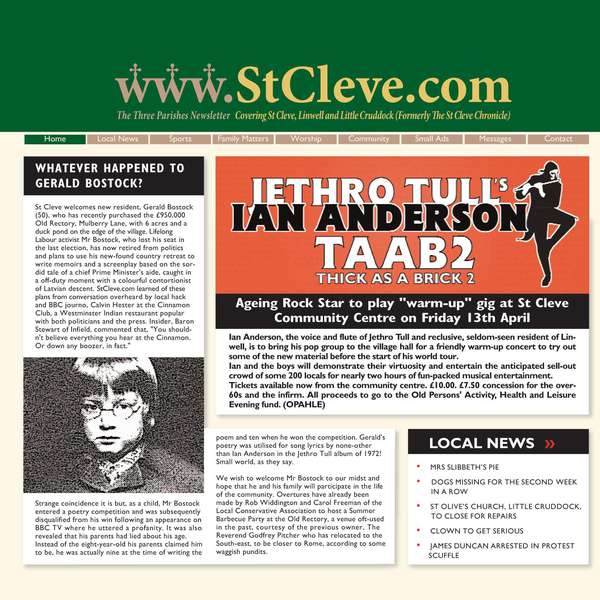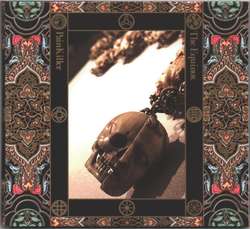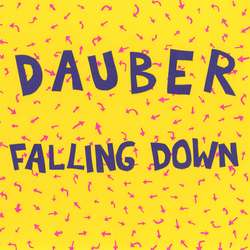If there's anything movies have taught us, it's that sequels almost always suck in comparison to the original. While there aren't nearly as many sequels in the musical world, occasionally an artist will go back and revisit one of the ideas that made them famous in the first place. In almost all of these cases, such as with Mike Oldfield's endless Tubular Bells reinterpretations, the final product winds up, for lack of a better term, blowing. It languishes as a pale imitation of the original, merely a failed attempt to recapture one's own past greatness. But then, on that rare occasion, an artist will not only create a sequel that doesn't suck, but a sequel that holds up well in comparison to the original, and, even more rarely, a beautiful album in its own right. Folks, Ian Anderson's Thick as a Brick 2, a direct sequel to his band Jethro Tull's 1972 hit Thick as a Brick forty years on, is one such an album.
There are many musical references to the original album, but what makes this album great is that none of them feel forced. All of the musical references within the body of the music are subtle and played with maturity, being respectful to the original while developing themselves within a new context. Most of the time, the themes are so seamlessly blended into the surrounding music that you don't even notice that they're there, and even when you do notice them, they don't draw unnecessary attention to themselves. They take the original piece and build upon it so much that they develop their own legitimate, distinct musical identities. Sure, it's pretty obvious that Anderson is recapitulating the original theme at the end of the album and opening it with the fade-in from part two of the original, but those are the only incredibly obvious moments, and forgivable in that they act as bookends to frame the rest of the album.
And, even without reference to the original album, the music itself is nonetheless incredibly beautiful folk-influenced progressive rock. Anderson remains one of the few people ever to pull off being a rock flautist (if only Peter Gabriel had done more!), and he uses it to his distinct advantage. Not only the flute, but all of the folk instruments on the album sound absolutely beautiful, no small thanks due to Steven Wilson's superb mixing. While some of the songs do feel like they end ever too quickly, nothing is played without reason, so the album is entirely without filler. "From a Pebble Thrown" and "Swing it Far" are both wonderful songs in the traditional Tull folk rock style, full of catchy melodies and fantastic instrumental playing. "Banker Bets, Banker Wins" is a hard rocker full of edginess and sharp playing, "Pebbles Instrumental showcases the band's wonderful soloing abilities, and "Wootton Bassett Town" is a surprisingly delicate, symphonic piece. "A Change of Horses" particularly deserves note as an incredibly beautiful progressive rock epic, every bit as amazing as the Jethro Tull standards "Aqualung" or "Minstrel in the Gallery". The songs on this album also effortlessly blend elements of spoken word in with the music itself, creating a feeling that perfectly captures the poetic imagery of the original without imitating it directly. Something similar can be said for the album art, which superbly updates the original newspaper cover concept for the modern day into something that clearly pays homage to the original while still being distinctly unique.
Lyrically, the album builds upon the original wonderfully. For those of you who aren't familiar with the original, its concept was centred around a poem about the tribulations of growing up written by a fictional boy named Gerald Bostock. He was disqualified from a poetry contest when his folks lied about his age, so, in a sort of meta-conceptual manner, the band Jethro Tull took the poem from this character and set it to music as inspiration for their next album. This time around, Anderson's poetic music focuses on the many possible different futures for the fictional Bostock, now fifty, and how he inevitably winds up back in the same place. This is a brilliant adaptation of the original album's concept, as it doesn't directly imitate it musically (another album-length song would've likely been a mistake), but it does build upon its lyrical content in a novel manner.
Yes, you inevitably can hear Anderson's age, but he masks it very well, working cleverly around his limitations rather than struggling with them head-on. His vocal range is noticeably definitely lower and more mellow, and as a result, you can hear the pieces tend to be lower to compensate. You can also hear that he can't quite sing those nimble parts on the original "Thick as a Brick" theme as well as he used to. But, much to his credit, the musical tempos never seem to lag, something contemporaneous bands like Yes and even the usually steadfast Rush are now succumbing to. This album sounds almost like something that could've been released in the midst of Jethro Tull's heyday.
Even the bonus DVD, which is usually full of useless chaff, is chock full of interesting material. Though the "making of" featurette is pretty much the average fare for the genre, the embellished mixes sound absolutely delightful, and the interviews are actually incredibly informative, even if the sound quality leaves something to be desired. The lyric reading videos are surprisingly fun to watch, showcasing Anderons' vastly under-appreciated poetic spoken word talents. The St. Cleve webpages are an amusing substitution for the newspaper, especially because they've got that dated early-90s kitschy Internet-illiterate feel to them that is so difficult to capture well. And finally, the lyric translations are likely to be appreciated immeasurably by those folks who can't even read this review in the first place (let alone the DVD titles, now that I think about it).
The thing is, there are so many ways that this project could have easily gone wrong right from the get-go, and the fact that Anderson has not only the know-how but the physical capability to deliver a wonderful result despite this is incredibly admirable. Thick as a Brick 2, while not a perfect album, is so much better than it has any right to be. To end on another film analogy, this album is The Godfather: Part II when we should've expected The Matrix Reloaded.





